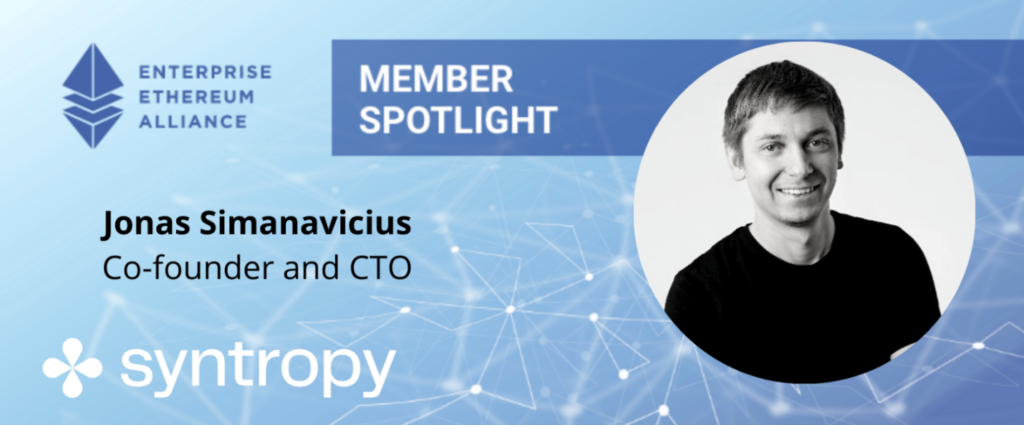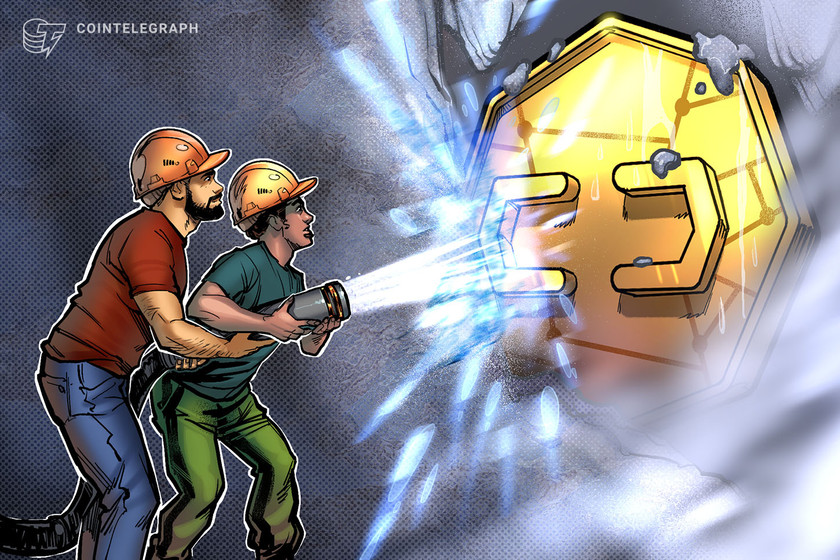EEA Member Spotlight with Jonas Simanavicius, Co-founder and CTO at Syntropy

EEA Member Spotlight with Jonas Simanavicius, Co-founder and CTO at Syntropy
As an EEA member, Syntropy is part of the EEA community of organizations working to advance Ethereum and drive industry adoption. In the Q&A below, the EEA interviewed Jonas Simanavicius about how Syntropy is helping the ecosystem achieve the potential impact of Ethereum.
the Q&A below, the EEA interviewed Jonas Simanavicius about how Syntropy is helping the ecosystem achieve the potential impact of Ethereum.
Please introduce your company and yourself briefly
Syntropy transforms the public internet into a secure and user-centric internet, where encryption and optimized performance are built-in and automatically enabled for anything and everything connected to it. Through our internet unification layer, we are connecting all cloud and bare-metal locations from 200+ providers and 550+ unique regions, leveraging all underutilized network capacity found across the web.
Anything built on the current internet can also be built on Syntropy using the Syntropy Stack. It allows anyone to create and deploy applications on Syntropy, with connections automatically optimized-for-performance and encrypted-by-default. The stack is also compatible with millions of devices and services, including cloud, on-premise and edge infrastructure. We are giving developers the power and control to build on our unifying layer.
Before starting Syntropy, I was part of the engineering and application development teams at Royal Bank of Scotland and JPMorgan Chase. It was there where I learned about Bitcoin and the potential impact that decentralized technologies could have on the world. Connecting the utility of blockchain with my expertise in networking software was a clear opportunity that I could not pass up. Teaming up with other successful tech entrepreneurs (including a co-founder of Equinix) set the rest in motion.
What first brought you to the Enterprise Ethereum Alliance, and why did you decide to become a member?
Joining the alliance made perfect sense for us given the utility of Ethereum and its obvious place in the enterprise market. We developed our technology with direct input from many enterprises, so being able to learn from even more EEA members made this an ideal match. The alliance also helps us stay up to date on business trends related to developer tools, tokenomic models, smart contract security, blockchain adoption, etc. It’s not only a great opportunity to engage with potential new users, but also collaborate with some of the most promising Ethereum-based projects and organizations.
What are you currently working on with regards to Ethereum? How will end-users benefit from your work?
Syntropy already utilizes Ethereum smart contracts, but right now we are adding the final pieces to our tokenomic model, which puts our ERC-20 token, NOIA, at the core of our protocol. In addition to this, we recently launched the Syntropy Stack, which helps developers and network teams to easily create secure optimized connections between any of their devices or services running on cloud, on-premise, or edge locations.
We think it’s a big deal for the blockchain industry as the stack can make decentralized infrastructure faster, more secure, and highly reliable. This positions Syntropy to become the go-to technology for building blockchain infrastructure, ensuring that all connections become formalized, encrypted and streamlined. Syntropy facilitates networks at its core so we realized early on that we could equip the average node runner with the right tools and remove the complexity that comes with setting up nodes.
How will the EEA enhance your organization’s current efforts?
The Syntropy tech stack has already launched. It’s tailor-made for enterprise applications. It solves real needs enterprises face every day, including the cost and hassle of setting up and managing vast networks, handling security breaches, and dealing with suboptimal internet performance.
By aggregating enterprise users and technologies like ours, we hope to bridge the gap between next-gen services and large potential users to solve real business needs.
As mentioned, our technology is also ideal to simplify and augment blockchain infrastructure setups. We’ve already done pilot tests with decentralized services like Chainlink and Polkadot — including an official integration with Elrond — and believe most Ethereum-based applications (including Ethereum itself) could benefit from our technology. We want to work with every project and network to strengthen the decentralized Ethereum ecosystem.
What EEA programs are you most excited about?
For me, it is the working groups within the alliance. Specifically, the Trusted Execution Task Force and the EthTrust Security Levels Working Group, both of which cover topics that could greatly improve our network and keep us up to date on best security practices. The blockchain-based payments interest group also looks interesting as we are seeing a lot of attention placed on token adoption and crypto regulations.
Our team and technology can be strong contributors to these areas. Learning and working with fellow members on these issues would be equally as valuable.
Learn More and Connect with the EEA
The EEA enables organizations to adopt and use Ethereum technology in their daily business operations. We empower the Ethereum ecosystem to develop new business opportunities, drive industry adoption, and learn and collaborate. Our global community of members is made up of leaders, adopters, innovators, developers, and businesses that collaborate to create an open, decentralized web for the benefit of everyone. Join us and contribute to our work!
Learn more about EEA membership, sign up for the latest updates and contact membership@entethalliance.org.
The post EEA Member Spotlight with Jonas Simanavicius, Co-founder and CTO at Syntropy appeared first on Enterprise Ethereum Alliance.






